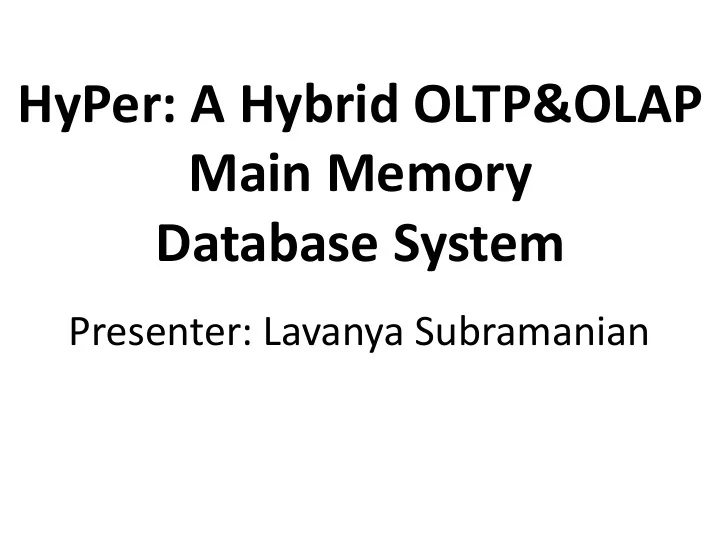

HyPer: A Hybrid OLTP&OLAP Main Memory Database System Presenter: Lavanya Subramanian
Need for Online Analytics • Business intelligence today demands fresh data • Business analytics of yesterday – Transactions are run on an OLTP database – OLTP database state extracted periodically – Analytics performed on the extracted state • The “perform analytics offline” model too stale and slow for today’s business intelligence
How To Perform Online Analytics? • Run transactions (OLTP queries) and analytics (OLAP queries) on the same machines • Problem: Long running analytics queries interfere with transactions
HyPer: Key Idea • In-memory database runs transactions & analytics • Transactions are run on the main database • Snapshots are created for analytics – by forking the OLTP process • Properties of snapshots created on a fork() – Data is not duplicated rightaway – A page is duplicated only when modified (copy-on-write)
Basic Transaction Processing Model in HyPer • Builds on prior work on in-memory transaction processing • Single-threaded execution is effective enough – No IO wait times • Short transactions – No interactive transactions
Analytical Processing in HyPer Image Credit: Alfons Kemper
How Does Copy on Write Work? 1) High latency 3) Cache pollution Memory CPU L1 L2 L3 MC 2) High bandwidth utilization 4) Unwanted data movement Image Credit: Vivek Seshadri
Hardware Support For Fast Copy-On-Write 3) No cache pollution 1) Low latency Memory CPU L1 L2 L3 MC 2) Low bandwidth utilization Image Credit: Vivek Seshadri
Parallelizing Analytics and Transactions
Multiple OLAP Sessions • Snapshots for OLAP – Do not consume much space – Can be created easily using fork() • Parallelize OLAP query execution – Using multiple snapshots – Executing on idle CPU cores • Snapshot deleted after last query of a session
Multi-Threaded Transaction Processing • Execute multiple read-only queries in parallel • Execute read-write queries in parallel – Scenarios where data can be partitioned – Transactions confined to partitions • Only one transaction per partition • Cross-partition transactions run single threaded
More Discussion on Transactions • Snapshot Isolation • Durability • Transaction Consistency
Snapshot Isolation • Roll-back – Roll back when an older query needs older data • Versioning – Create a new object version on every update – Retrieve youngest version before query start time • Shadowing – Write updates to a shadow copy – Update main copy upon commit • Virtual memory snapshots
Durability • On failure recovery, all effects of committed transactions should be restored • Solution: Logical redo logging – Apply log to database after failure recovery • Redo log can be used to feed a secondary server – Potential uses: standby, analytics processing
Transaction Consistency • Perform Undo logging to obtain a transaction consistent snapshot • Applied to a snapshot created from a fork() – To undo effects of current transactions
Methodology • Benchmark – TPC-C scheme – Additional three relations from TPC-H • Hardware – Intel X5570 – Quad Core CPU – 64 GB DRAM • Comparison Points – MonetDB (for analytics) – VoltDB (for transactions)
Results - Performance and Memory Consumption
Memory Consumption
Discussion • Simple mechanism that exploits an existing feature of virtual memory management • How would memory consumption increase with multiple snapshots? • Is their OLTP performance evaluation fair?
Recommend
More recommend